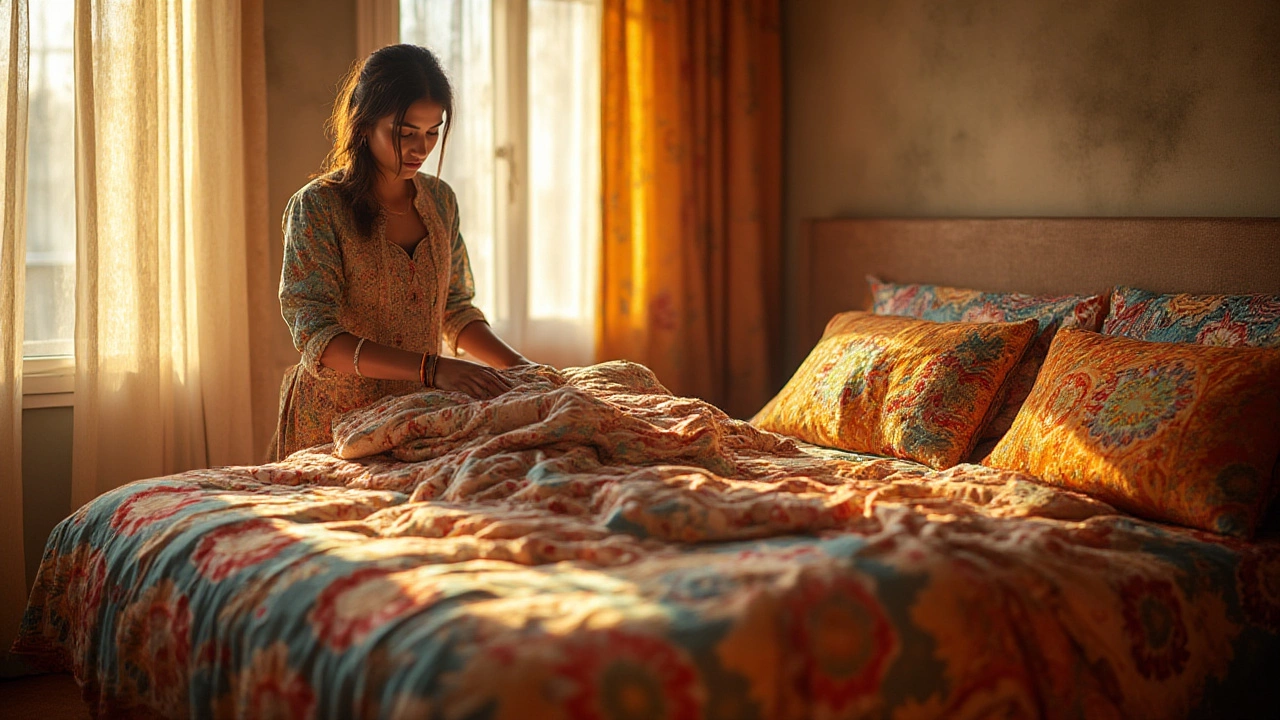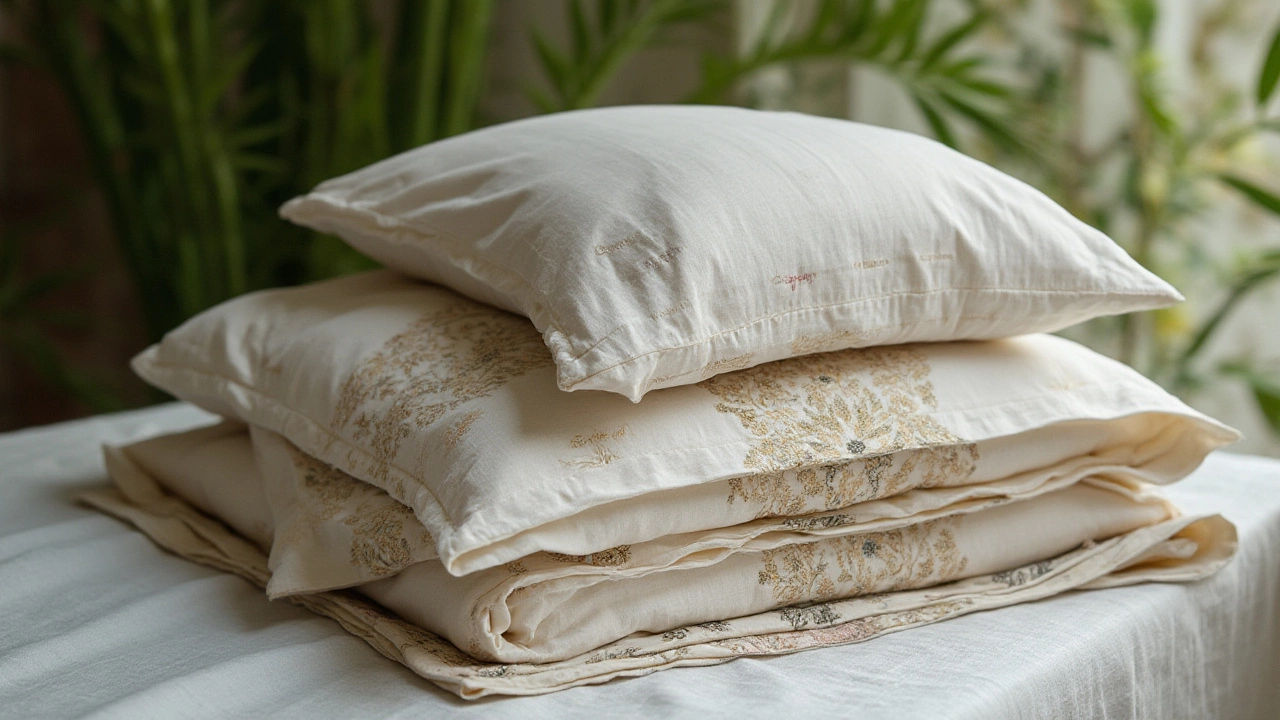Is Bedding the Same as Linens? Key Facts About Bed Linens Explained

Ever rolled into a hotel room, eyed that neatly made bed, and wondered—are those folds, sheets, and fluffed-up pillows called bedding, linens, or maybe both? You're not the only one. Most folks mix up these terms, even though companies, hotels, and home stores throw them around like everyone’s supposed to know the difference. Rufus, my sock-stealing dog, couldn’t care less, but for everyone else who wants their sleep setup spot-on, it’s actually pretty important.
What Exactly Are Linens? Origin, Meaning, and Evolution
The term "linens" originally stems from the word linen, a fabric made from the flax plant, which people have used for thousands of years. If you go back to ancient Egypt, linen was prized for its coolness in the heat and lasted longer than just cotton or wool. They even wrapped their mummies in it! If you think about it, that’s a pretty big endorsement—what you choose to sleep in might be fit for a pharaoh's tomb.
But here’s the twist: even when newer materials like cotton or microfiber stole the show in modern bedding, the term "linens" stuck. Today, people use "linens" as a catchall phrase for bed sheets, pillowcases, duvet covers, and sometimes even tablecloths or napkins—even if there’s no actual linen fabric in sight. Funny enough, a recent survey by a home goods store revealed almost 70% of people had no idea what “linens” technically mean. They just know it’s the stuff you put on your bed. So, nowadays, if someone says "fresh linens," it's generally understood they’re talking about any freshly laundered items that go on your bed or table, regardless of what they’re made of.
There’s a little overlap with the hospitality world, too. When hotel staff chatter about "changing the linens," they’re replacing your pillowcases, sheets, and sometimes the duvet cover—not the pillows or mattress itself. Here’s a quick snapshot of typical linen fabrics seen in bedding today:
| Fabric | Features | Common Use |
|---|---|---|
| Linen | Breathable, cool, strong | Premium bedding, summer sheets |
| Cotton | Soft, absorbent, affordable | Everyday sheets, pillowcases |
| Microfiber | Lightweight, wrinkle-resistant | Budget sheets, guest beds |
| Silk | Luxurious, temperature-regulating | Pillowcases, high-end sets |
Like clothing, the actual fabric matters for comfort, temperature, and even allergies. Ever woken up sneezing from feather-filled pillows? That’s not only about what’s inside the pillow but also the material on top of your mattress or sheets.
Bedding vs. Linens: What's the Real Difference?
Here’s where it gets tricky. The terms "bedding" and "linens" are used interchangeably, but they aren’t exact twins. Bedding is a broader term that covers everything you sleep with or on top of. That means not just sheets and pillowcases but also comforters, duvets, blankets, bedspreads, mattress protectors—basically, if it’s on your bed, it falls somewhere under bedding.
Linens, in the world of home goods and housekeeping, refers mostly to the items that actually touch your skin—fitted and flat sheets, pillowcases, and sometimes the duvet or duvet cover. This is why you often hear people talking about "changing the linens" rather than "changing the bedding." For anyone who wants to get really technical, the American Association of Textile Chemists and Colorists points out that “bed linens” officially means sheets and pillowcases, while "bedding" might include quilts, coverlets, comforters, and blankets. As a textile expert, Dr. Hannelore Mitlacher, put it in House Beautiful:
"Linens traditionally referred to flat-woven sheets and pillowcases made of flax, but over time, it's become an umbrella term for any material in contact with the skin during sleep."
Let’s break down a typical bedding set and see where the overlap is:
- Fitted Sheet (Linen)
- Flat Sheet (Linen)
- Pillowcases (Linen)
- Duvet Cover (Linen in some homes, Bedding in others)
- Comforter/Duvet Insert (Bedding only)
- Blankets/Throws (Bedding only)
- Mattress Protector (Technically Bedding)
Next time you’re out shopping, and you see packaging labeled "100% Egyptian Cotton Linens," you’ll know it’s talking about the skin-touching stuff, not the fluffy comforter. Stores sometimes mix and match the terms, mostly for marketing. Plush duvets can be called both "bedding" and "linens"—it really depends on how traditional the brand is or if they’re aiming for a luxury vibe.
And here's a little tip: when buying online, always check the product details. A "sheet set" usually includes just the fitted sheet, flat sheet, and two pillowcases. "Bedding sets" could include extras like a duvet cover or even the comforter itself.

Fun Facts, Myths, and Laundry Realities
Here’s a weird one: most Americans only change their bed linens about every 10-14 days, but the Sleep Foundation says once a week is actually ideal if you care about skin health and allergies. Seems a little ambitious, right? If your dog, Rufus, has ever snuck on your bed with muddy paws, you’ll know sometimes it’s more like twice a week.
People love bedding myths. Think thread count is king? Not so fast! Comfort and durability don’t just come from a bigger thread count number. A 600-thread-count sheet made with high-quality cotton can feel silkier and last longer than a 1200-thread-count made with cheap fibers. Look for long-staple cotton (like Egyptian or Pima) for real softness, not just marketing fluff.
Another quirky point—not all "linens" are white. Classic hotels want white because it’s easy to bleach and assures guests that everything’s clean. At home, though, don’t be afraid to try colors or patterns, just make sure to check for colorfastness so they don’t fade on the first wash.
And speaking of washing, here's how to keep things fresh and comfy:
- Wash sheets and pillowcases once every week or so.
- Don’t cram the machine; your linens need space to get really clean.
- Skip high heat—it can shrink or damage fibers, even if they say pre-shrunk.
- Drying outside gets that sun-fresh smell, but if allergies bug you, dry them inside.
- Use gentle detergent and halve the fabric softener to keep things soft but not gummy.
Ever unfold an old sheet and get a musty whiff? That’s because linen materials, especially natural ones, soak up moisture—including sweat, humidity, occasionally drool. Store them in a cool, dry place, never in plastic. Cotton and linen love to breathe.
Choosing the Best Linens (and Bedding) for Your Bedroom
Your choice of "linens" can totally change how well you sleep. Think about what you need. Run hot at night? Look for pure linen or percale cotton sheets. Freeze at night even in July? Brushed cotton or flannel adds warmth. Allergy-prone? Hypoallergenic microfiber could be your best friend, though it may not have that crisp, classic feel traditionalists love.
Don’t just chase after the highest price tag. Sometimes, you’re paying for a brand name, not better comfort. Try to touch and feel the fabric first (store swatches can help), or check return policies just in case. Bamboo sheets are getting hype because they’re soft, moisture-wicking, and sustainable, but high-quality cotton is still the workhorse of most American homes.
If you want to give your space a quick hotel upgrade, here’s what most experts and hospitality insiders recommend:
- Invest in two to three sets of quality linens per bed. This gives you a backup for laundry day and emergencies (like spilled coffee or pet accidents).
- Mix and match textures—linen with cotton, or cotton with a knit throw—to balance coolness and coziness year-round.
- Consider color that matches your décor but isn’t too trendy. Classic shades like white, soft gray, or taupe feel timeless.
- Label shelves in your linen closet so you know which set fits which bed (especially important with family or guest rooms).
- For durability, avoid bleach except for whites, and use mild detergents. Vinegar in the rinse can keep linens extra soft.
Spend a little time on care, and you’ll notice your "linens" (whatever their true fabric) will stay crisp, cozy, and look like a million bucks—even if your dog’s already claimed the pillow. If you ever want to geek out with more stats and research, the National Sleep Foundation’s annual survey dives deep into how fresh sheets boost sleep quality. A whopping 73% of responders said they snooze better in freshly washed linens.
So, is bedding called linens? Sometimes, yes. Linens usually mean the parts touching your skin—fitted sheet, top sheet, and pillowcases. Bedding covers all that and the warm stuff on top. Grab what fits your sleep style, learn what’s hiding behind those store labels, and keep them clean. After all, there’s nothing like that fresh-sheet feeling—unless, of course, you’re Rufus, who just wants to burrow under the covers no matter what they’re called.